
Quaesitosaurus
The gentle giant of ancient Asia.
Period
Cretaceous
Length
Roughly 20 meters long.
Height
Around 10 meters tall at the shoulder.
Weight
Approximately 20,000 to 30,000 kg.
Quaesitosaurus was a large herbivorous dinosaur from the Late Cretaceous period. It belonged to the group known as sauropods, which were characterized by their enormous size and long necks. Fossils of Quaesitosaurus have mainly been found in what is now Mongolia, providing crucial insights into the diversity of dinosaur life in Asia. This dinosaur likely roamed the vast landscapes in search of plant material to consume.
Diet
Quaesitosaurus was a herbivore. It fed primarily on plants, using its long neck to reach vegetation that other herbivores could not access. Its diet would have consisted of a variety of plant material, including leaves, ferns, and possibly conifer needles.
Hunting
As a herbivore, Quaesitosaurus did not actively hunt. Instead, it relied on its size for protection against predators. The dinosaur moved slowly across the landscape, stripping leaves and branches with its teeth.
Environmental challenges
Quaesitosaurus faced environmental challenges such as changing climates and food scarcity during drier periods. The vast distances it traveled meant it needed to find areas with sufficient vegetation to sustain its large size. It also had to protect itself from predators that roamed the same environments.
Speed
Relatively slow due to its massive size.
Lifespan
Estimated to have lived several decades.
First discovery
Discovered in 1983 in Mongolia.
Fun Facts
- Quaesitosaurus was a dinosaur that lived during the late Cretaceous period, around 80 million years ago.
- Its name means 'extraordinary lizard' due to its unique features.
- Quaesitosaurus was a sauropod, which means it was a long-necked, long-tailed, plant-eating dinosaur.
- Fossil evidence suggests Quaesitosaurus might have had a unique skull shape compared to other sauropods, although complete skulls have not been found.
- This dinosaur is known from fossils that were discovered in Mongolia's Gobi Desert.
- Quaesitosaurus likely lived in a semi-arid environment with seasonal rains.
- Despite its large size, its fossils indicate it might not have been one of the heaviest or longest sauropods.
Growth and Development
Like other sauropods, Quaesitosaurus likely experienced rapid growth during its early years. This rapid growth may have helped it avoid predation by reaching a large size quickly. Adult Quaesitosaurus would have continued to grow, but at a slower rate compared to their juvenile stages.
Habitat
Quaesitosaurus inhabited vast plains and forested areas where it could access a wide variety of plant life. The environment consisted of open spaces that allowed its large body to maneuver easily. It may have traveled in groups to locate the best feeding grounds.
Interaction with other species
Quaesitosaurus likely coexisted with a variety of other dinosaur species, including predators and other herbivores. Its large size meant that it did not have many natural predators, but it did compete for food resources with other plant-eating dinosaurs. The presence of Quaesitosaurus might have influenced the behavior of smaller herbivores and carnivores within the same habitat.
Natural lifespan
Quaesitosaurus lived a long life, potentially several decades.
Reproduction
Quaesitosaurus likely laid eggs, as with other sauropods. It may have used nesting sites where the eggs were buried and incubated by natural heat from the ground. Young Quaesitosaurus possibly received some degree of protection from adults.
Social behaviour
Quaesitosaurus may have been a social animal, traveling in groups for added protection against predators. Group behavior would have also facilitated finding food and caring for young. Interaction with conspecifics likely played a role in their survival and reproduction.
Fossil locations
Fossils of Quaesitosaurus have been primarily found in Mongolia. These discoveries provide valuable information on the diversity and distribution of sauropods in Asia during the Late Cretaceous period.
